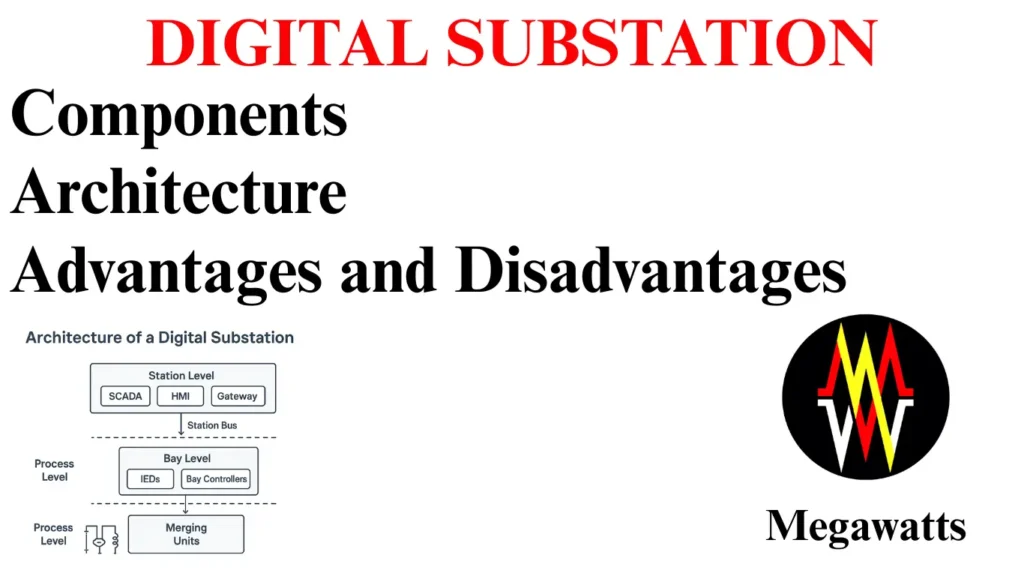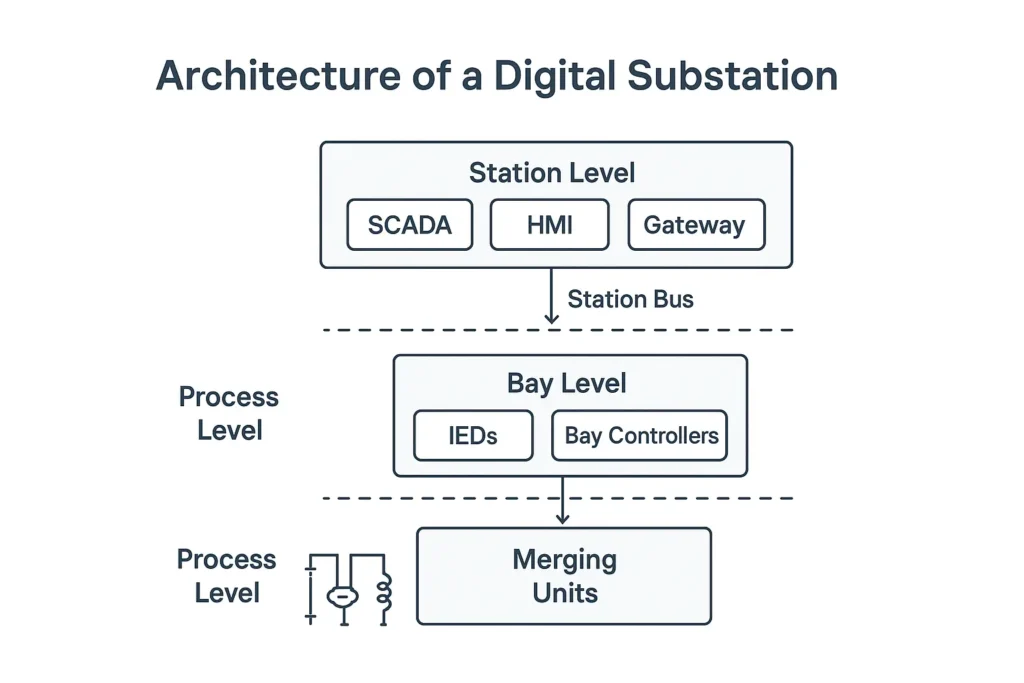
A digital substation is a modern electrical substation, where the use of copper cable for communication between various conventional relays is minimal; rather, optical fiber is used for communication between circuit breakers, transformers, and IEDs (Intelligent Electronic Devices). The raw electrical signals used in older substations are replaced in a digital substation with digital data flowing over a common Ethernet connected to all IEDs with a common communication protocol as IEC 61850.
Table of Contents
Main Components of a Digital Substation
Primary Equipment
Transformer: It is the main equipment in any electrical substation, responsible for stepping up / down in voltage or transforming power.
Current Transformer: The current transformer is used to provide a toned-down current input that is directly proportional to the actual current flowing in the circuit for the purpose of metering and protection.
Potential Transformer: The potential transformer is used to provide a toned-down voltage input that is directly proportional to the high voltage existing in the circuit. This input is used for metering and protection purposes.
Circuit breaker: It is used to make or break a live circuit. The arc in the process is extinguished inside the circuit breaker.
Isolator: It is used to isolate a dead circuit physically for the purpose of maintenance.
Earth Switch: It is a connector that essentially grounds the circuit. Normally, it comes along with the isolator assembly and is used only on the line side.
Merging Unit
A merging unit (MU) is a device that takes conventional analog electrical inputs from CTs and PTs and converts them to standard digital data, which is then transmitted via a communication network to the IEDs, be it control and protection related, and also to the SCADA system. The sampling of signals is done at a defined rate and is time synchronized with the GPS or PTP (Precision Time Protocol). Merging Unit allows one set of CTs and PTs to serve multiple IEDs at the same time with no parallel wiring.
Intelligent Electronic Device (IED)
IEDs are intelligent electronic devices that are digital and microprocessor-based, used in substations for protection, control, monitoring, and communication. IEDs are the brain of the digital substation, as it can sense and detect faults in the circuit and send a trip signal to the master trip relay of the circuit. The IEDs can operate breakers and other switching devices remotely. These are also capable of maintaining a log of power system parameters like voltage, amperes, and power factor. Also can record the fault events for disturbance analysis. IEDs can communicate with other IEDs and provide real-time data to SCADA for the substation management.
Process Bus
A process bus is basically a communication network between the primary equipment of the substation and IEDs via the merging unit. It replaces the copper wiring between switchyard equipment (CT & PT) and the control room with an optical fiber connection. The type of data that flows in the process bus are standard value (SV), which are digital versions of the electrical signals of CT and PT via the merging unit and GOOSE (Generic Object Oriented Substation Event) message, which is a peer-to-peer communication system like IEDs issuing a trip command. The standard protocol for process bus is IEC 61850-9-2 Sampled values and Goose messaging
Station Bus
Just like the process bus, the station bus is a communication network between the IEDs’ control system and the SCADA of the substation. This network handles protection, control, monitoring, and supervision signals by replacing control cables in a conventional substation with optical fibers. The data type that flows in this bus are alarms, events, status of equipment, control commands, and measurements. Example: Trip signal from a protection IED to breaker control IED, opening/closing of the breaker via SCADA. The standard protocol for station bus is IEC 61850 MMS (Manufacturing message specification).
SCADA
SCADA stands for Supervisory Control and Data Acquisition. In the context of a digital substation, it is used for monitoring, controlling, and managing the substation operation remotely in real-time via communication with IEDs through the station bus. It collects the real-time data from IEDs and displays it on the screen, providing situational awareness for the operator. SCADA systems are capable of controlling the operation of switchgears remotely from the control room, thereby managing the load flow. SCADA raises alarms during abnormal conditions of the power system and the malfunction of equipment, helping the operator to take quick action. It also stores the system data, which is helpful for system analysis later.
Cyber security
- In a digital substation, cybersecurity is about protecting the communication modules that are the process bus, station bus, and SCADA links from hackers so that the substation operation remains reliable and safe. In order to achieve this,
- All the networks must be segregated, and firewalls must be implemented.
- The access to the network must be multifactor authenticated.
- The communication between IEDs, SCADA, Control room must be encrypted for secure communication.
- The LAN (Local Area Network) must be monitored for abnormal traffic
- IEDs, Gateway, and Servers must be regularly updated to fix vulnerable loopholes.
Architecture of Digital Substation
The architecture of a digital substation is based on three major layers:
Process Level: It includes primary equipment like CT, PT, Transformer, isolator, breaker, and other sensors that give out electrical inputs. The process level also includes a merging unit, which converts the electrical input into digital signals and transmits them to the process bus.

Bay Level: It includes IEDs, which include protection relays, the controller of the bay, and its machine interface. This level is for the execution function of the protection and interlocks, as well as control functions. For example: Issuing of the trip command after receiving sampled values from the process level.
Station Level: It includes the SCADA system, gateway server, and HMI (human machine interface). Storing data, raising alarms, Engineering workstation are some of its core features. At this level, remote communication with the control room is handled along with the supervisory control.
This layered process-bay-station architecture makes the digital substation faster and more reliable.
Advantages
Space saving: Reduced copper wiring reduces complexity and electromagnetic interference. The non-conventional instrument transformers and merging unit are very compact since they do not use a magnetic-iron core and hence save space in the switchyard and control room as well.
Fast Communication: Faster and reliable communication is achieved with real-time data transfer and GOOSE messaging.
Improved Safety: The safety is improved as optical fibers are potential-free and are protected from shock, risks of fire, etc.
Flexibility and scalability: Since it has a modular architecture, integration of a new bay is simple and easy.
Reduced downtime: Since digital data can help with predictive maintenance, it helps reduce the outages and blackouts.
Reliability and Resilience: Faster fault clearance and automation with built-in redundancy of the communication network increases reliability and grid resiliency.
Disadvantages
Higher Upfront cost: The fiber optics system, along with IEDs and all infrastructure, requires a high upfront cost, which is significantly higher than a conventional substation.
Cybersecurity risk: Since the communication is IP-based and digital, cybersecurity risk will always be present, and hence, the system requires constant security upgrades.
Highly skilled workforce required: The Operation and maintenance team requires highly skilled workers who are trained in networking and cybersecurity. Less skilled manpower is a challenge.
Technology obsolescence: Since digital technology evolves fast, hardware and software need frequent upgrades to keep the system secure.
Maintenance challenge: While substation preventive and predictive maintenance is easy, maintenance of servers, IEDs requires special tools and training.
Applications
Transmission sector: The application of digital substation is mainly seen in the transmission sector (132KV and above) for its reliable protection, ease of monitoring, and automation.
Renewable energy integration: A Digital substation handles power fluctuations easily and enhances protection, and provides an advanced monitoring solution.
Smart Grid: Since it supports demand response, two-way communication, remote monitoring, and predictive analysis, the digital substation forms the core of the smart grid.
Remote and offshore platforms: Since fiber optics’ performance does not deteriorate in harsh environments, and digital control can be established remotely, it becomes suitable for offshore and remote platforms and sites.
This article is a part of the page Substation Guide.
